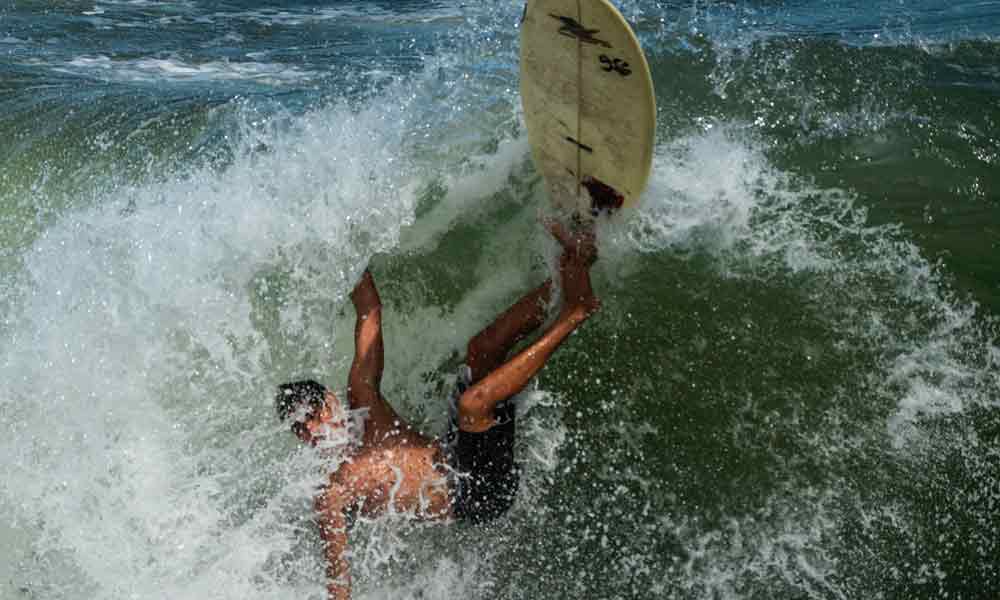A surfing wipeout is something you’ll have to get used to when you take up this sport.
It’s hard to avoid as a novice, and even as a skilled surfer it’s something that you can’t escape.
But understanding how it happens, why it happens, and what you can do about it will make your time on the waves easier, dryer, and much less painful.
What is a Surfing Wipeout?
A wipeout is a term used to describe the moment that a surfer is thrown off their surfboard by a wave.
The surf is unpredictable. Sometimes, if Mother Nature throws a big wave your way, the only way to survive is to bail.
Some of the other terms to familiarize yourself with include:
Over the Falls
A bad wipeout that occurs when the surfer gets sucked to the top of the wave and falls from the lip. There is a high chance that they will hit the reef or ocean floor, in which case they could suffer from a serious injury.
Axe/Drill
When the lip of a wave smashes into a surfer, cutting through them like an axe or drill.
Pearl
When the nose of the surfboard dips underneath the water on the steep part of the wave, greatly increasing the risk of a wipeout.
Spin Out
A surfer “spins out” when they turn too sharply on the wave and the surfboard slides out from underneath them.
Two Wave Hold Down
A wipeout that leaves the surfer trapped under the surface of the water for two successive waves.
The Most Epic Wipeouts
Wipeouts appeal to our morbid curiosities.
They are dangerous and potentially life-threatening, and yet we can’t turn away and videos of the “best wipeouts” get millions of views.
If you can’t resist an epic wipeout, take a look at the following shocking moments.
And don’t feel too guilty, as all of the surfers involved survived—some more intact than others.
Jay Moriarity’s Wipeout at Mavericks
Jay Moriarity was just 16-years-old when he was filmed wiping out at Mavericks back in 1994.
It’s not the most epic in history, but it’s certainly the most iconic, and the image of this young surfer about to wipeout made it onto the front cover of Surfer magazine.
Tom Dosland’s Wipeout at Jaws
Tom Dosland’s epic wipeout came at Jaws back in 2016.
He makes it to the lip of the wave and then loses control.
He is spat from the surfboard and seems to fall in slow motion, still tied to his craft.
Andrew Cotton’s Wipeout at Nazare
Andrew Cotton’s wipeout won Wipeout of the Year away in 2018. It occurred during the monstrous waves at Nazare and it may take a couple of viewings to fully comprehend just how crazy it was.
The young English rider is flung out of the wave with his legs outstretched in front of him, looking like he’s sitting on an invisible craft as he flies through the air.
He hit the surface hard, so hard, in fact, that he broke his back.
Are Wipeouts Dangerous?
Surfing wipeouts can be very dangerous, causing broken bones, broken surfboard, and other serious injuries.
The bigger and heavier the wave is, the greater the risk of injury will be.
Some of the bad things that can go wrong include the surfer being hit by their own surfboard, landing on a rocky bottom, or being spat out of a tall wave.
Don’t assume that you’ll be safe because you’re on water.
If you fall from a high enough height and in the right way, that water can feel like concrete.
Many surfers have died on the waves and countless others have been seriously injured.
A large number of those deaths occur when they are knocked unconscious by their surfboard or razor sharp reefs, leading to drowning and serious head injuries that may be prevented by wearing a helmet when surfing.
How to Avoid a Wipeout
It’s often said that if you’re not wiping out, it’s because you’re not surfing hard enough or long enough.
In other words, it will happen at some point.
However, there are some ways that you can reduce the risk of a wipeout.
Learn the Topography and Conditions
Before you head out into the surf, make sure you know it like the back of your hand.
Are there any sharp reefs, rip currents, and underwater rocks?
Does it have a sandy bottom or a rocky bottom?
What do other surfers say about the risks and do they have any advice for you?
Stay Away From What You Can’t Handle
If you’re a novice surfer, you should stay clear of large surf.
Don’t paddle into waves that you can’t handle and simply wait for things to calm down, keep your distance, or save your surfing for another day.
Watch and Learn
Bide your time, remain patient, and watch the large surf before you head into it.
Give yourself at least 10 minutes to watch those waves break and fall and only head into them when you’re confident that you can handle them.
Watch for Other Surfers
You should know where other surfers are at all times.
Many serious injuries occur when surfers or their surfboard collide. Keep your eyes peeled, be aware, and don’t stray too close to another surfer.







